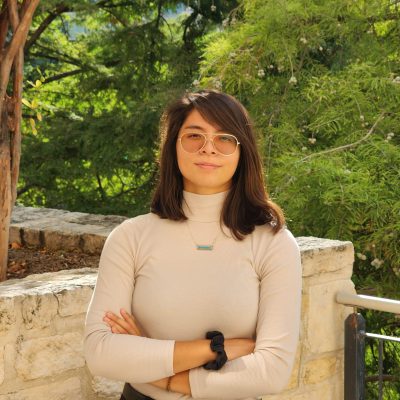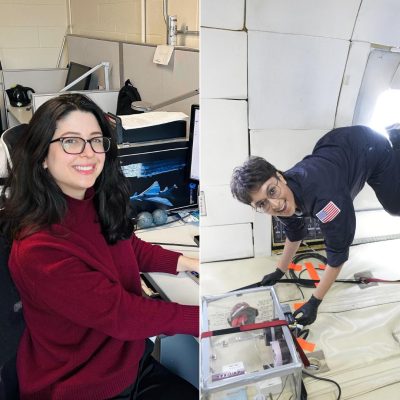
Allison Porter: A rigorous design methodology to prepare for medical emergencies in space
Original article via MIT Morningside Academy for Design
NASA’s plan to send astronauts on a roundtrip flight from Earth to Mars in what will likely be an 850-day mission has MIT Morningside Academy for Design (MAD) Fellow Allison Porter thinking about how distance-delayed communications with Earth could put astronauts in danger when medical emergencies arise. At some points during the trip, the spacecraft will be so far from Earth that communications with Mission Control in Houston could have up to a 24-minute delay in both directions.
Porter, who is a first-generation college student, earned her bachelor’s degree in biological systems engineering in her home state of Nebraska. She’s now finishing up her doctoral work in Harvard-MIT Health Sciences and Technology (HST), the academic unit of the MIT Institute for Medical Engineering and Science (IMES). Her project will inform the future work of engineers determining how best to integrate automation into guidance for astronauts — who may not be medical experts — using clinical tools in spaceflight. The work will also be useful in extreme environments on Earth, such as mountain base camps and other highly remote areas.
Although the Mars flight is unlikely to occur before 2040, the young biomedical engineer, who previously designed a soft-knee exoskeleton for advanced spacesuits as her master’s thesis project in MIT’s Department of Aeronautics and Astronautics, understands that now is the time to begin preparations. She’s aspiring to help lay the groundwork for a new field. And with her focus on involving clinical experts throughout the design process, she’s introducing a rigorous design methodology at the most basic planning level. It’s this aspect of her research that brought her to MIT MAD for her final year at MIT.
“My definition of ‘design’ in this project really encapsulates a process to first fully understand a complex system, and then use that information to meet the needs of the system.”
“This means that I’m diverging from the simplified engineering paradigm of (1) Define a problem; (2) Ideate a solution via design; (3) Build; and (4) Perform human-in-the-loop testing to evaluate the efficacy of the designed solution,” Porter says.
“Rather, we are opting to involve humans in the loop as part of the design process, not just in testing. We are doing this rigorously and extensively – not just consulting with one domain expert briefly at the beginning or at intervals of the design phase, but using continuous, multi-source domain expertise input throughout our process to directly inform our design.”
Porter’s research advisors are Aleksandra Stankovic, an assistant professor in the Department of Psychiatry at the Harvard Medical School who is on the faculty of the HST Bioastronautics Program; and Katya Arquilla, assistant professor in the Department of Aerospace Engineering at the University of Colorado Boulder and formerly of MIT, whose research is focused on quantifying human health and performance during interactions with complex systems.
Porter adopted this design methodology in part because during her literature review for the project, she found that “automated clinical support tools that exist on the ground are not appropriate for long-duration exploration medicine; they seemed to rely on highly trained individuals, often were one-off systems, and have low adoption rates,” she explains.
Porter’s research is focused specifically on the use of ultrasound technology as a diagnostic tool during medical emergencies, and possibly to guide the work of astronauts providing treatment in space.
“I wanted to better understand how experts in a hospital setting on Earth perform care in something that’s relevant to spaceflight, particularly point-of-care ultrasound (POCUS) in cases of traumatic injury,” Porter says.
To do this, Porter observed and interviewed health care professionals who use POCUS in trauma cases, including at the Massachusetts General Hospital (MGH) Department of Emergency Medicine, rural hospitals, and even more austere wilderness settings. For instance, POCUS can sometimes be used to determine quickly the extent of an abdominal or chest injury or to check for fluids in the membrane lining the abdominal cavity or the membrane sac enclosing the heart.
Porter’s familiarity with anatomy comes in part through HST courses that taught her the anatomy and physiology of several organ systems, helping her to better understand the pathophysiologies that can occur in spaceflight. Through her observations at MGH and the Veterans Affairs Hospitals in Boston, she was able to gain a greater understanding of the everyday use of bedside ultrasound operations. “This was vital as I prepared for formal observations and interviews regarding POCUS for my study,” she says. She also incorporated cognitive engineering methodologies, qualitative analysis, human factors engineering and bioastronautics into her research.
As the only HST and AeroAstro student in this year’s MIT MAD cohort, Porter says she’s learning to “translate, to speak more fundamentally about my work to peers in other fields. Design is our common language.”
After graduation, Porter will work as an aerospace engineer in NASA’s Exploration Mission Planning Office at Johnson Space Center in Houston, where she hopes to apply her human-systems engineering skillset to help make expeditions safer for astronauts and Earth explorers alike.

